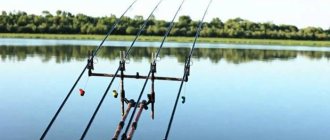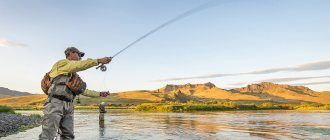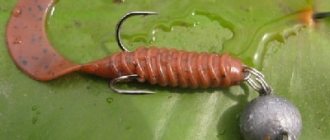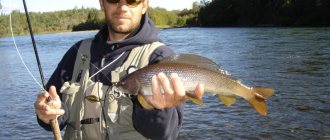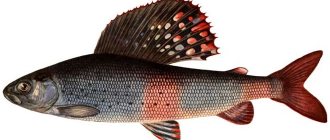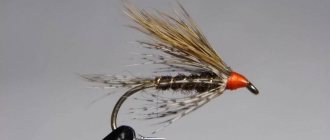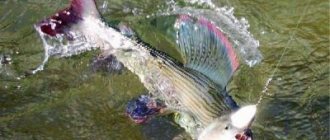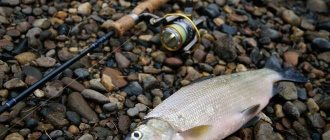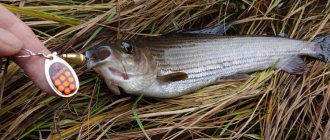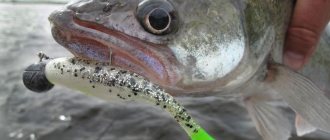Catching grayling is incredibly interesting, regardless of the time of year. This exotic fish for many fishermen, shrouded in an aura of mystery, is quite widespread in our country. Grayling is found everywhere in Russia, with the only exception being the southern part of the country, directly adjacent to the Black Sea coast. Another thing is that some densely populated areas with serious problems with the cleanliness of the ecological situation due to industrial pollution of rivers do not allow this representative of salmon to survive and reproduce in numbers capable of providing fishermen with opportunities for regular and stable fishing.
In this regard, when planning a trip to a reservoir in search of grayling, you need to familiarize yourself with the legislative framework of the region you are visiting and make sure that the extraction of this trophy is permitted by law and does not constitute poaching or the destruction of a small species of ichthyofauna of the area. Having made sure of the legality of his actions, all that remains is to catch the grayling, and the angler will learn about fishing technology, behavioral characteristics of the fish and the best time to catch it from the article presented below.
Description and behavior characteristics
Grayling is one of the brightest and most distinctive representatives of the salmon family, living in freshwater. The fish is a cold-loving species and feels comfortable in reservoirs with water temperatures that do not rise above 17 degrees. In appearance, it is a runaway fish with small, dense scales and a high dorsal fin covered with bright multi-colored dots. It is simply impossible to confuse even a accidentally caught specimen with other fish species.
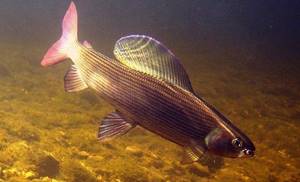
Fishing for grayling, due to its year-round increased nutritional activity, is possible throughout the year. The fish is omnivorous, although grayling is considered a pronounced predator, which is confirmed by the presence of miniature teeth in the form of bristles. The diet of the population is formed based on the seasonality of the release of a particular food item. At its core, the fish conducts a wait-and-see manner of hunting, choosing a convenient parking spot and picking up food passing by, without particularly moving around the reservoir. Leads a school life, huddling in a group of a dozen similar-sized fish and inhabiting a certain territory.
Spawning in fish is portioned and can consist of three exits, which occur in the spring-summer period of the year. Grayling fishing in summer and spring does not stop due to the mating season due to the spawning of different schools of fish at different periods of time.
Features of the choice of lures and bait for grayling
In the summer, when fishing, you can use a fairly large number of baits and choose any water bodies. There are no additional conditions for fishing in the summer; you can use almost any method.
For example, in winter, this matter becomes more difficult. When fishing with a worm, you must be prepared and stock up from the summer. In fishing stores and in winter you can find anything on the shelves, and this saves many. Grayling has one distinctive feature: it is crazy about cottage cheese. And sometimes this is what destroys him. Fishermen learned to lure him with a bag of cottage cheese. He will, of course, bite not on the bag, but on a piece of foam plastic, mistaking it for cottage cheese.
in the fall , but it becomes more difficult to do so. The fish, of course, is trying to eat before the winter period, but is already moving to deeper places. After September, midges practically no longer fly and you have to look for food at the bottom. Based on this, when fishing you should exclude surface baits; grayling will not fall for them. And it’s better to switch to long casts; in the autumn the fish become more careful.
Well, in the spring, the fish go to spawn and catching them becomes a pleasure. But after the emigration period, it begins to get sick and recover, so it is advisable to stop fishing a little after spawning.
The chosen gear greatly influences successful fishing. The number of fish, its weight and size depend on it. Let's take a closer look at each type.
- A float fishing rod - this option is optimal for fishing in small reservoirs or rivers. You need to hold it in such a way that the float is always in motion, this will quickly attract the attention of the fish. It works well with bait in the form of live flies, moths, butterflies and, in principle, all live baits. Artificial ones are more suitable for the winter period.
- Spinning is also an option for small bodies of water. It should be no more than three meters long and you need to know how to use it. You need to hold it above the water, periodically lowering it, attracting the attention of the grayling. The bait for it is mostly artificial, both underwater and surface. But for long casts it is recommended to use underwater artificial baits.
- Donka is a device for any time of year. But, it is noted that in winter it bites much more. Artificial baits with diving are an ideal option for this gear.
- Winter fishing rod - it is very convenient to fish in small holes, but it is worth remembering that fishing in one place for a long time is not recommended. Frequent movements will help organize a larger catch. The baits for it are the same as for the float.
- Fly fishing - anglers consider this method the most effective. A rod measuring about three meters is thrown into the water. There are a wide variety of lures for fly fishing, you can specifically choose an option to match the color of the water, and they are chosen at will, since all lures are suitable. Which tackle to choose is a personal matter, but it is worth remembering all the nuances of natural conditions, the size of reservoirs and your capabilities. When purchasing baits, you can turn to specialists, but it is not always possible to carry out these actions. In this case, fishing baits can be made with your own hands.
Main types of grayling
Before you start fishing, you need to imagine that grayling has several varieties, differing in appearance and size. This feature is noted based on the region where the individual lives.
The largest specimens are the Siberian fish species. Individuals of this subspecies reach a mass of three kilograms and have distinct teeth, and the size of the upper jaw reaches the eyes. The color scale of the scales varies from red to purple. Fishing for this large grayling is carried out in the Siberian region and the Far North.
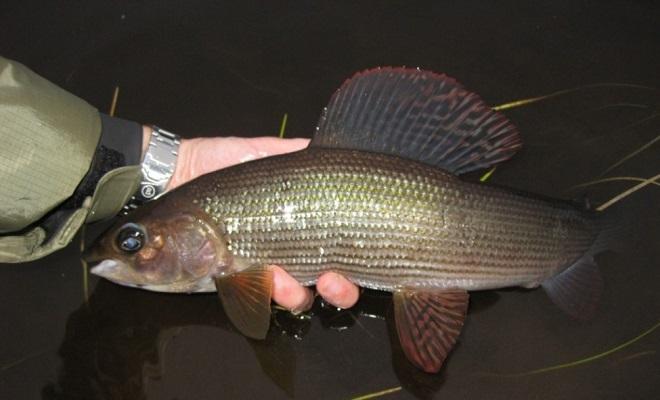
Siberian large grayling
The European species is distinguished by an elongated body and an expressive high and multi-colored dorsal fin with 24 rays. The back of the fish is gray-green in color, with the presence of dark spots of various shades. A small mouth with a lower position and very small, barely noticeable teeth. Its weight rarely reaches 1.5 kg, and individuals do not grow over 50 cm in length. The described species is widespread in the European part of the country.
The Mongolian species is considered to be the smallest representative among graylings. But despite this disadvantage, the fish has the largest teeth and a long head. The dorsal fin is gray, covered with white spots. The rest of the plumage of the fish is orange with lilac tints and edging. For the most part, the Mongolian species inhabits the river basins of the Far Eastern region. Grayling fishing is promising on small rivers and fast streams in this region remote from the European part.
Where are grayling found?
This representative of the salmon family can safely be called an ecological indicator of a reservoir, because the fish lives only in clean water, fully saturated with oxygen. Fishing for grayling near large industrial areas is obviously doomed to failure, since the fish, sensitive to the content of harmful impurities in the water, simply cannot produce healthy offspring.
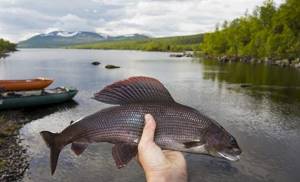
The usual habitats of fish are streams and fast rivers with a pebble bottom, where the fish arrange their camp sites in areas where the flow slows down. Graylings also inhabit lakes with cold waters coming from mountain ranges. The depths of such reservoirs rarely exceed the ten-meter mark. When fishing for grayling on small rivers, they focus on riffles and channel turns with accelerated currents and adjacent backwaters.
Important! For a predator to live, aquatic thickets are not a mandatory attribute in the water areas themselves and near the coastlines; fish love free and far-visible areas, which determines the cleanliness and transparency of the water in the habitats of this population.
Flocks love to inhabit areas of reservoirs with tributaries of rushing streams and the presence of a large number of underwater springs with a constant release and flow of fresh and cold water.
Grayling fishing in summer
Grayling prefers cool water at any time of the year. In summer, fish hide from the heat in shady areas with an influx of spring water. The optimal places for summer fishing are considered to be rifts with a rocky bottom , as well as coastal steep banks with abundant vegetation.
The appearance of insects adds to the hassle of fishermen choosing bait. It is important to use natural bait or imitations of those insects that fly out en masse during a particular period. The fish bite best in the afternoon before dark.
What does it eat?
The predator’s diet is based on collecting insects that fall into the water, as well as various small animals inhabiting the reservoir itself. Dragonflies, all kinds of moths and flies, grasshoppers that fall on the water immediately become a desirable dish for this nimble fish. Waterfowl beetles, water striders and insect larvae will definitely find themselves in the zone of interest of a school of grayling. During periods of spawning of other fish neighboring graylings, these predators do not disdain the opportunity to feast on laid eggs, collecting eggs floating past them, carried away by the water from the spawning ground. At the moment of the release of fish larvae and fry, specimens caught in the stream also become victims of feeding fish.
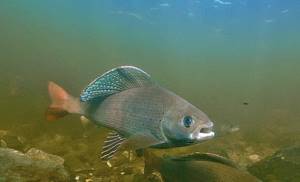
Important! The predator does not purposefully pursue the prey, waiting for it to approach its parking place in a stream of water. It feeds both from the surface and in the middle water horizons, never descending to the bottom.
Based on these facts about its nutrition, bait and groundbait for grayling is fed purely into the water column, without touching the bottom at all.
Grayling fishing in autumn
Grayling fishing in the fall has its charms and difficulties. First of all, it should be noted that the fish has managed to accumulate fat and, when fished, offers powerful resistance. But for a good catch you need to know the grayling feeding areas. Coastal waters are the most attractive for fishing. Experienced fishermen carefully examine not only the water streams adjacent to the shore, but also the areas off the opposite shore. Grayling bites in the middle of the river are quite rare.
In autumn, the bait should move slowly through the water column. Sometimes fish bites occur only after monotonous fishing of the same point. By the way, in the fall, schools of grayling migrate to the lower reaches, where they prepare to spend a long winter .

Autumn grayling in Siberia
Grayling biting calendar by season
The grayling bite is observed throughout the year. The fish are active and continue to feed both in open water and during periods of freeze-up. All you have to do is adjust for the intensity of how grayling bites in a certain season of the year, and the level of biting intensity directly depends on the temperature of the water and its transparency, and is also related to the time of population reproduction, which, as mentioned above, is a cyclical process.
Spring is not considered a particularly productive time for grayling fishing. After the ice melts, the water is not transparent and reliable knowledge of where the fish are staying is required so that the bait can be delivered as accurately as possible within the predator’s visibility range.
Important! The peculiarities of fishing for spring grayling require a constant search for parking places for feeding schools and the use of clearly visible and noisy baits that can attract the interest of fish, which can be achieved by fishing for grayling with a bombard.
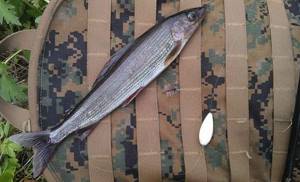
The fisherman should not forget about the decrease in fish activity during the spawning period, the first part of which falls in the spring months.
Summer fishing is difficult due to the large amount of food available to the fish, since the constant flight of various insects saturates the predator, making it picky and capricious in its diet.
Important! Grayling fishing in summer is most successful in the surface layers of water using all kinds of insect imitations, selected according to the shape of the mayfly at the time of fishing.
It is these correctly selected artificial baits that determine the success of fly fishing. The ongoing spawning may only provide anglers with a bite for a couple of summer weeks.
The autumn season is included in the rank of mining time. The decrease in the number of available insects and the approaching freeze-up season force the fish to feed more actively and move around the reservoir more often, changing their parking place, which only benefits the angler. After all, now you don’t need to constantly look for fish, but you can persistently fish for a promising point in the hope that a flock of predators will approach. Now the bait for grayling is supplied to the middle horizons of water, which is much clearer than summer, and even more so spring waters. The trophies themselves are distinguished by their fatness and size, and the bites are much faster and almost always bring a positive result in terms of catching fish.
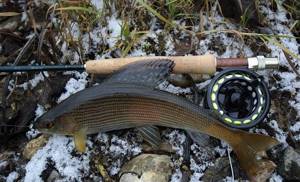
In winter, after freeze-up, fishing continues, fishing from the ice above the deeper parts of the reservoir. Methods of catching grayling from summer options are transferred to ice fishing, using both artificial and natural animal baits as bait. The fish continues to stand on fast currents, waiting for the approach of an object suitable for feeding, and therefore does not critically change the strategy of its behavior.
Grayling fishing in spring
With the onset of spring, you can go looking for grayling. Ice drift often creates many interesting fishing spots in rivers. A distinctive feature of grayling is its spring migration to the upper reaches of rivers. This occurs before spawning, so the fish actively feeds while moving.
The fish migration occurs in April, although everything depends on the nature of winter and air temperature. At the end of April or beginning of May, grayling spawns. Therefore, it is advisable for fishermen to spend the spring in the upper reaches of rivers, as well as on small rivers.
What to catch grayling with
Lures for grayling are varied and consist of artificial baits and baits of natural animal origin. The method of their use directly depends on the fishing method used. Some of the popular methods of hunting are fly fishing and spinning fishing. These techniques typically use a number of artificial baits. Float fishing and jig fishing are practiced with natural baits of animal origin. Using the method of catching fish using a boat, catching grayling with a bombard and casting can be done with both artificial and animal baits.
Natural baits
Of the natural baits, insects that stand alone can be distinguished: dragonflies, moths and butterflies, large flies, bees, bumblebees and, of course, grasshoppers, suitable for successful fishing. You can use worms, bloodworms, maggots, and caddis flies throughout the year, and especially when fishing from ice. Inert baits for catching grayling include fish meat and shrimp.
Artificial baits
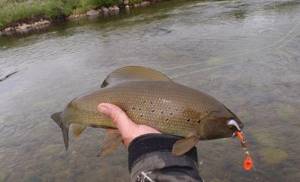
The list of artificial baits is no less interesting and, first of all, it is worth noting the use of a fly for grayling, which anglers can purchase at a fishing store, or can successfully tie individually at home.
Important! Depending on the material used, the fly can be dry, which does not lose its shape when placed in water, or wet, which, when wet, takes on the natural shape of a crumpled, drowned insect.
Wobblers, cranks for ultralight spinning fishing and rotating spoons also attract predators with their frisky play. No less popular among spinners are miniature silicone baits, the so-called slugs, which imitate the appearance and movements of insects and underwater larvae and beetles.
Catching grayling with a Tyrolean stick
Many spinning anglers use an unusual equipment called a Tyrolean stick when fishing for grayling. The principle of operation of the equipment is in many ways similar to the operation of a diverter leash. The role of the sinker is performed by an elongated stick equipped with a passage ring.
- Spinning tackle is selected for fishing conditions. The length of the rod is limited to the range of 2.1-2.7 m.
- A monofilament line of 0.18-0.20 mm is wound on a spinning reel with a 2000 spool.
- A Tyrolean stick is mounted on the base and secured with a bead.
- A fly, wobbler or silicone fish is tied to a leash 0.14-0.16 mm thick. Important: the length of the leash should be less than the size of the stick, and the bait should be selected lighter than the Tyrolean rig .
Retrieving is done very slowly; even during a pause, the stick makes the bait play, attracting grayling.
How to catch grayling
Tackle for catching grayling should be distinguished by the lightness of the forms and components of the equipment, as well as the subtlety of installation.
Important! Hunting for this representative of salmon fish is quite dynamic and requires constant monitoring of baits, and for fly fishing, special training in the skill of casting a fly.
When completing tackle for spinning, float and fly fishing, select the lightest graphite rod, the use of which will not tire the angler with frequent casts. For cords, nylon fishing lines are used, which perfectly dampen the jerks of caught fish, and hooks are used with an elongated shank, size 10–12. Wade fishing is always more successful than shore hunting, and the presence of waders for an angler will help to significantly increase the number of catches. The angler will learn about the features of using various fishing methods and baits depending on the season of the year from further material in the article, with a focus on the main nuances of the technology.
in spring
For still muddy spring waters, the use of float gear is justified, with the help of which baits of animal origin are placed in the middle water levels above the places where the fish are supposed to stay.
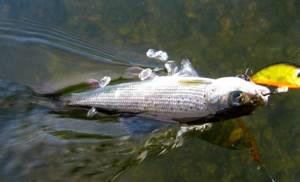
Important! The speed of the wiring is comparable to the speed of the current without delays or stops. The nature of the presentation of an insect, thin dung worm, bloodworm or maggot does not cause suspicion in the fish and if the presentation trajectory is successful, it will definitely take the bait.
Fishing using bombards and wobblers with low-frequency, not sweeping action is effective. The float should keep the bait in the middle water horizon, and the wiring itself is performed at an average pace of winding the cord without pauses or freezes.
In summer
In the summer, fly fishing becomes the priority method of catching predators. Fishing is done from the surface using a dry fly as bait. Fly fishing for grayling on riffles and rapids brings more bites than on the borders of fast and standing water. After casting, the fly is allowed to swim along the surface with slight twitches and pauses. The slightest touch of the bait by the fish is accompanied by an energetic hook. Long distances are fished using a floating bombard, relocating the predator's supposed stopping place. Bringing the fly to a promising point, they make holds and pauses, at the moment of which the bite occurs.
in autumn
In the fall, fly fishing continues, but the best fly will be in the wet version. The predator stops taking bait from the surface and begins to hunt in the water column. Spinning fishing using small spinners and silicone can be superior to fly fishing in terms of catchability. Uniform movements, without touching the bottom, are carried out on rapids and on the trajectories of contact of the main current with the creeks. In the fall, it is justified to use a boat equipped with both artificial flies and hooks with bloodworm and maggot attachments.
in winter
After the pond freezes, fishing is carried out with winter fishing rods, light balalaikas, with the installation of jigs and replanting bloodworms on them. The bait is played in the water column, making low throws alternating them with a short pause. On currents, they use the ice fishing technique using float equipment, placing an artificial fly as bait, which is fed into the middle horizons of the water and lures a predator, playing with the force of the current. Fishing with winter baits placed along the stream using flies or small silicone as bait is no less productive.
Grayling fishing in winter
In winter, grayling continues to lead an active lifestyle, delighting anglers with its bites. The first ice is considered the best period for catching grayling .
- Ice appears on the lakes first. Here you can catch beautiful fish using jig tackle, a vertical spoon or balancer, as well as a bulldozer.
- River fishing usually takes place on frozen holes and pools, where large numbers of fish accumulate. It is possible to interest the fish with the help of fly agaric jigs or baitless jigs. It is often useful to plant a couple of maggots or a worm.


